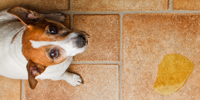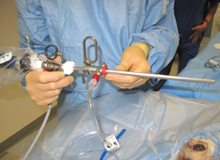
The treatment of urinary incontinence depends on the cause.
In Part 1 and Part 2 of this series, we looked at causes of urinary incontinence in female dogs and how your vet will investigate the problem and reach a diagnosis.
In this article, we explore the current options for managing the condition
Treatment for urinary incontinence due to an infection

A urinary tract infection will need to be treated with antibiotics
If bacteria have been found in urine which has been collected straight from the bladder by your vet (a procedure called ‘cystocentesis’), then the use of a long course of antibiotics is vital. Your vet will have performed a test to tell them which antibiotics are going to kill off the specific bacteria which is causing the urinary tract infection.
It is important that a further urine sample is collected by your vet 2 weeks into the antibiotic course and tested. Your dog should still remain on the antibiotics. If that urine sample shows that there are no bacteria present, your dog should complete a 4 week antibiotic course and then 2 weeks after finishing the course, your vet will need to collect and look at a further urine sample to ensure the infection has completely resolved.
Treatment for urinary incontinence due to ectopic ureters
If you remember, in Part 1 we talked about a defect in the urinary tract ‘plumbing’ – a condition known as ‘ectopic ureters’.
Surgery is advised to correct ectopic ureters. This technique is usually performed by opening up the bladder and creating a new opening in the abnormal section of ureter that is tunneling into the wall of the bladder. Use of a laser via a special scope is available at some specialist centres and means that open surgery is not required in these cases.
Resolution of the urinary incontinence following surgical intervention can be up to 60%. It often takes a good few months following surgery to allow all the tissues to settle down and also allow the juvenile dogs to further mature and have a season before we ultimately know if they have any residual urinary incontinence. If there is still some incontinence, it may be due to a coexisting element of reduced bladder neck tone (‘acquired urethral sphincter mechanism incompetence’) and the patient may benefit from some medication which is listed later in this article.
Treatment for incontinence due to ‘acquired urethral sphincter mechanism incompetence’
For those juvenile (ie sexually immature) bitches with suspected acquired urethral sphincter mechanism incompetence, 50% will become continent once they have had their first season. So, it is very important not to neuter a female dog with incontinence as this procedure could make the problem worse. For mature dogs with acquired urethral sphincter mechanism incompetence, sadly, we are unlikely to be able to cure the condition, but hopefully with the options detailed below, we may be able to improve this distressing situation for both pet and owner.
Medication for urinary incontinence in female dogs
There are currently 2 groups of medication that can be tried, either alone or in combination, for female dogs with urinary incontinence due to acquired urethral sphincter mechanism incompetence.
Phenylpropanolamine and ephedrine
These are two drugs that increase urethral tone. Phenylpropanolamine is given as a liquid two or three times daily and ephedrine tablets are given twice daily.
Oestrogens (Estrogens)
The second class of drugs are oestrogens and they are given in tablet form, usually once daily. Oestrogens aim to improve smooth muscle contractility and can also enhance the sensitivity of the urethral receptors to medications such as phenylpropanolamine. Oestrogens should only be used in neutered females.
If the above medications give an improvement or resolution of the incontinence, they do need to be continued for the effect to be maintained. Sometimes over time, bitches can become non-responsive to the medication and the incontinence reoccurs. Some bitches will however, be responsive to the medication for many years, with their urinary incontinence well controlled.
Surgery for urinary incontinence in female dogs
There are a number of different options available for the surgical treatment of acquired urethral sphincter mechanism incompetence. However, none of them offer an ideal solution for every patient.
Urethropexy
Urethropexy relocates the bladder neck further forwards into the abdomen. Two sutures are placed through the wall of the urethra and secured to the tendinous structure in front of the pelvis. Success rates during an average 2.9 year follow up period were that 56% of bitches were completely cured, 27% of bitches improved and 17% showed no change.
Colposuspension
Colposuspension is another way of relocating the bladder neck further forwards into the abdomen. The effect is that the bladder neck may be better responsive to the changes in intra-abdominal pressures as the bitch gets up or lies down. This procedure was developed for use in women and is still widely used in both women and female dogs. Success rates during an average 2.8 year follow up period were that 53% of female dogs were completely cured, 37% of female dogs improved and 9% showed no change.
Urethropexy and Colposuspension combined has recently shown some promising results with 70% of females still having an excellent response to the surgery at a 3 year follow up period.

Customised urethrocystoscope used to deliver the urethral bulking agents
Intraurethral bulking agents
These aim to increase the resistance to urine outflow. The advantage of this procedure is that it does not require actual surgery. The urethral bulking agents are delivered by a customised scope. Success rates during an average 17 month follow up period where collagen had been used as the urethral bulking agent were that 68% of the bitches were completely cured, 25% of the bitches improved and 7% showed no change. Relapse of incontinence can happen as the bulking agent flattens down, but further bulking injections can be given, though each time the urethra is injected the tissue becomes tougher and less accepting. New water based gels are being used as a bulking agent in women and in some canine patients in the UK and these may give a longer lasting effect than collagen.

An artificial urethral sphincter. The cuff is at one end and the injection port is at the other.
Artificial urethral sphincters
These are a relatively new concept that is being used and considered for some patients in the UK, Europe and the USA. They aim to increase resistance to urine outflow and comprise of a silicone cuff that is inserted surgically around the outside of the urethra. This cuff is connected to a thin tube which runs from the abdomen and connects to an injection port which sits under the skin. Just the presence of the silicone cuff can increase urethral resistance and improve or resolve the incontinence. However, for those dogs that need more resistance, the cuff can be partially inflated. Reported success rates vary between veterinary centres. A large percentage of dogs do experience some short term minor complications such as a slight difficulty in voiding urine, cystitis and urinary retention. The potential advantage of the artificial urethral sphincters is that there is ongoing scope for improving the incontinence by using incremental cuff inflation.
Transvaginal obturator tape
This is a technique widely used in women and there are sporadic case reports in dogs. The technique involves passing medical grade tape through the natural openings of the pelvis to ultimately give a degree of pressure over the vagina which then transmits to the urethra, increasing resistance to urine outflow. This technique is not performed routinely in the UK.
So, as you have read, frustratingly there is not a clear cut solution to urinary incontinence, particularly when the underlying problem is a reduced urethral/bladder neck tone (acquired urethral sphincter mechanism incompetence).
Probably the best advice is to trial medical management, resorting to surgical interventions if the bitches with acquired urethral sphincter mechanism incompetence become refractory to medication or experience any side effects or difficulty in taking the drugs.
All of the above mentioned interventions for acquired urethral sphincter mechanism incompetence do not guarantee long term resolution of urinary incontinence.
 The Veterinary Expert| Pet Health
The veterinary expert provides information about important conditions of dogs and cats such as arthrits, hip dysplasia, cruciate disease, diabetes, epilepsy and fits.
The Veterinary Expert| Pet Health
The veterinary expert provides information about important conditions of dogs and cats such as arthrits, hip dysplasia, cruciate disease, diabetes, epilepsy and fits.
 The Veterinary Expert| Pet Health
The veterinary expert provides information about important conditions of dogs and cats such as arthrits, hip dysplasia, cruciate disease, diabetes, epilepsy and fits.
The Veterinary Expert| Pet Health
The veterinary expert provides information about important conditions of dogs and cats such as arthrits, hip dysplasia, cruciate disease, diabetes, epilepsy and fits.